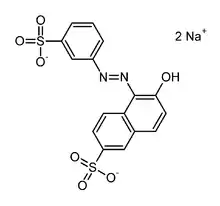Orange GGN
Orange GGN, also known as alpha-naphthol orange, is an azo dye[1] formerly used as a food dye. It is the disodium salt of 1-(m-sulfophenylazo)-2-naphthol-6-sulfonic acid. In Europe, it was denoted by the E Number E111, but has been forbidden for use in foods since 1 January 1978.[2] It has never been included in the food additives list of the Codex Alimentarius. As such, it is forbidden for food use in general, because toxicological data has shown it is harmful.
 | |
| Names | |
|---|---|
| Other names
1-(m-Sulfophenylazo)-2-naphthol-6-sulfonic acid, disodium salt | |
| Identifiers | |
3D model (JSmol) |
|
| ChemSpider | |
| ECHA InfoCard | 100.017.340 |
| E number | E111 (colours) |
PubChem CID |
|
| UNII | |
CompTox Dashboard (EPA) |
|
| |
| |
| Properties | |
| C16H10N2Na2O7S2 | |
| Molar mass | 452.36 g·mol−1 |
Except where otherwise noted, data are given for materials in their standard state (at 25 °C [77 °F], 100 kPa). | |
| Infobox references | |
The absorption spectrum of Orange GGN and Sunset Yellow is nearly identical in visible and ultraviolet range, but they can be distinguished by their IR spectra.
References
- "Orange GGN".
- EU directive 76/399/EEC
This article is issued from Wikipedia. The text is licensed under Creative Commons - Attribution - Sharealike. Additional terms may apply for the media files.